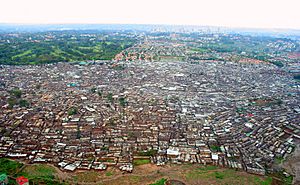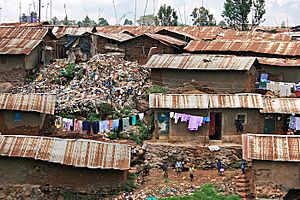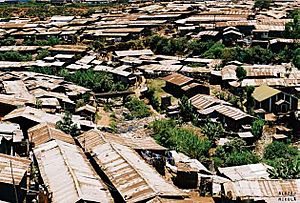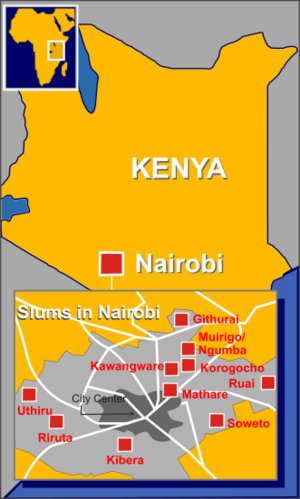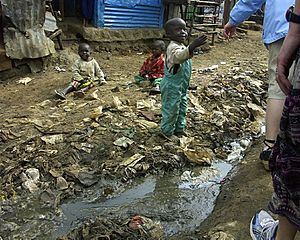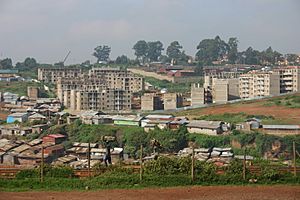Kibera facts for kids
Kibera (which means Forest or Jungle in the Kinubi language) is a large neighborhood in Nairobi, Kenya. It is about 6.6 kilometers (4.1 miles) from the city center. Kibera is known as the largest slum in Nairobi, and one of the biggest in Africa. A slum is an area where people live in very simple, often crowded homes, and where basic services like clean water and electricity might be hard to find.
In 2009, an official count (the Kenya Population and Housing Census) reported Kibera's population as 170,070 people. Before this, some estimates suggested there were one or two million people living there. Other sources still believe the total population could be around 500,000 to over 1,000,000, depending on which nearby areas are included.
Many people in Kibera live in extreme poverty, meaning they earn less than US$2 per day. It can be hard to find jobs, and there are not enough schools for all children. Clean water is scarce, and illnesses caused by poor hygiene are common. Most residents do not have access to basic services like electricity, running water, or medical care.
The government has started a plan to replace the slum with new apartment buildings. The idea is to move the residents into these new homes once they are ready.
Kibera is made up of several smaller villages. These include Kianda, Soweto East, Gatwekera, Kisumu Ndogo, Lindi, Laini Saba, Silanga, Makina, Salama, Ayany, and Mashimoni.
Contents
History of Kibera
How Kibera Started
The city of Nairobi began in 1899 when a railway line was built. This railway needed a main office, and the British colonial government set up offices there. The British wanted Nairobi to be a place for Europeans, with African and Asian workers only staying temporarily. These workers were brought in for short jobs, often for the railway or lower-level government roles.
Between 1900 and 1940, the colonial government made laws to keep people separated. They limited where Africans and other workers could live. Africans were allowed to live in special "native reserves" on the edge of the city. Permits were needed to live in Nairobi, and these permits separated living areas by ethnic group.
One group of people were African soldiers who fought for the British army. Their assigned area grew into a settlement, which became Kibera.
Kibera started in 1904 when Nubian soldiers, who had served the British, were given plots of land in the forests outside Nairobi. The British government allowed this settlement to grow without much planning. Over time, other tribes moved into the area and rented land from the Nubian landlords. As Nairobi's economy grew, more people from rural areas moved to the city looking for work. This led to Kibera and other slums developing around Nairobi.
In the late 1920s, there were ideas to tear down Kibera because it was near European homes. However, the people living there did not agree. The colonial government thought about reorganizing Kibera, and a special commission looked into the "Kibera problem." By then, Kibera was not the only slum. A report in 1931 noted that housing for Europeans was good, but slums were common for Africans and other non-European workers.
After Kenya Became Independent
After Kenya gained independence in 1963, the government made some types of housing illegal. This meant Kibera became an unauthorized settlement. Even so, people continued to live there. By the early 1970s, landlords in Kibera were renting out their homes to many more people than was allowed.
The people who rent these homes are often very poor and cannot afford legal housing. The rents in Kibera are much cheaper. So, the number of residents in Kibera kept growing, even though it was not an official settlement. By 1974, the Kikuyu tribe made up most of Kibera's population.
Later, more people from the Luo and Luhya tribes moved to Kibera from western Kenya. By 1995, Kibera was mostly a Luo area.
Today, people from all major Kenyan ethnic groups live in Kibera. Many new residents come from rural areas where there are not enough jobs or resources. The mix of different ethnic groups, along with the importance of tribal identity in Kenyan politics, has sometimes led to small conflicts in Kibera over the years.
The Kenyan government owns all the land where Kibera stands. However, it still does not officially recognize the settlement. This means that basic services like schools, clinics, running water, or public toilets are not provided by the government. Any services that do exist are usually privately owned.
Geography of Kibera
Kibera is located in the southwest part of Nairobi, about 6.6 kilometers (4.1 miles) from the city center. The Nairobi river and the Nairobi Dam form much of its southern border. The dam used to provide drinking water to the city, and now there are two main pipes that go into Kibera.
Kibera is divided into thirteen villages and two estates. These include Kianda, Soweto East, Gatwekera, Kisumu Ndogo, Lindi, Laini Saba, Siranga, Makina, Salama, Ayany and Mashimoni.
Buildings in Kibera
The way Kibera is built changes a lot. Between 2006 and 2014, the number of buildings in areas like Lindi, Mashimoni, Laina Saba and Soweto East increased by 77%. This means the area became much more crowded. However, the overall layout of the buildings and pathways stayed mostly the same.
Population of Kibera
The 2009 Kenya Population and Housing Census reported Kibera's population as 170,070 people. Before this, Kibera was thought to be one of the biggest informal settlements in the world. Many groups had estimated its population to be over 1 million, saying it was the largest slum in Africa. For example, Mike Davis, an expert on urban slums, estimated about 800,000 people.
Other groups, like the International Housing Coalition (IHC), estimated over half a million people. UN-Habitat also gave various estimates, from 350,000 to 1 million people. These numbers were often based on looking at aerial photos of the area.
In 2008, a group of researchers started a project called "Map Kibera Project." They went door-to-door to map the area and collect information about the people living there. A team of local residents was trained to gather this data. So far, they have collected information on over 15,000 people and mapped 5,000 buildings and services like public toilets and schools in the village of Kianda. Based on their findings, the Map Kibera Project team estimated that the total population of Kibera could be between 235,000 and 270,000 people. This was much lower than previous estimates.
The main ethnic groups living in Kibera are:
- Luo: about 35%
- Luyia: about 29%
- Nubian: about 10%
- Kikuyu: about 7%
- Kamba: about 9%
- Kisii: about 4%
- Other groups make up the rest.
Services and Facilities
The Uganda Railway line runs through the middle of Kibera. This gives train passengers a direct view of the slum. Kibera has a railway station, but most residents use buses and matatus (shared taxis) to get to the city center.
Kibera faces serious pollution problems from human waste, garbage, and dust. The lack of proper sanitation, combined with poor nutrition, leads to many illnesses. A local organization called Umande Trust is building shared toilets that produce methane gas (biogas). This gas can be used by local residents.
There is also a community radio station called Pamoja FM. It works to improve not only Kibera but all slums in Nairobi. The Kibera Journal is a local newspaper that started in 2006. It covers issues affecting the people of Kibera and helps train young people in basic journalism skills.
Education in Kibera
Most schools in Kibera are considered informal, meaning they are not fully regulated by the government. However, many efforts are being made to add more schools. Some places start as daycare centers and later grow into schools.
Some well-known schools include Olympic Primary School, which is one of the top government schools in Kenya. Other public schools in Kibera are Kibera Primary School (also called Old Kibera), Ayany Primary School, and Toi Primary School. Facing the Future School (FaFu), along with several church-owned and private schools, are also in the area.
For older students, notable secondary schools include PCEA Silanga High School, owned by the Presbyterian Church of East Africa, Raila Educational Centre, and Olympic Secondary School. There is also the PCEA Emmanuel Technical Training Centre, which teaches skills for self-employment. The Tunapanda Institute offers free courses in technology, design, and business skills. Many local youth organizations, like the Kibera Black Stars football (soccer) team, are also involved in educational projects.
Improving Kibera
Kibera is one of the most studied slums in Africa. This is partly because it is located in the middle of Nairobi, and also because UN-HABITAT, the United Nations agency for human settlements, has its headquarters nearby. Even the former UN Secretary-General, Ban Ki-moon, visited Kibera.
Kibera is currently undergoing a major process called "slum upgrading." The government, UN-HABITAT, and many non-governmental organizations (NGOs) like Maji na Ufanisi are working to improve housing and sanitation conditions.
However, building or upgrading homes in Kibera faces three main challenges:
- Theft: Building materials cannot be left alone for long because they might be stolen. People whose homes are damaged by storms sometimes have to camp on top of the remains to protect their materials.
- Weak Foundations: The ground in many parts of Kibera is made of trash and rubbish. Homes are often built on this unstable ground, so many structures collapse when there is flooding, which happens often. This means even well-built homes can be damaged by nearby collapsing structures.
- Difficult Terrain: The area has uneven land and is very crowded. Few houses can be reached by vehicles, and many are at the bottom of steep slopes, which increases the risk of flooding. This makes construction harder and more expensive, as all materials must be carried in by hand.
Moving Residents to New Homes
On September 16, 2009, the Kenyan government, which owns the land, began a long-term plan to move people living in Nairobi's slums to new homes.
The plan to clear Kibera was expected to take between two and five years. The entire project aimed to rehouse all slum residents in the city over nine years and was estimated to cost $1.2 billion. The new communities were planned to include schools, markets, playgrounds, and other facilities.
The first group of about 1,500 people left the slum on September 16, 2009. They were taken by truck to 300 newly built apartments, which had a monthly rent of about $10.
The start of the project was delayed several times. Former Prime Minister Raila Odinga, who was the local Member of Parliament, helped residents load their belongings onto the trucks on the first day. Housing Minister Soita Shitanda and his assistant Margaret Wanjiru were also there, along with armed police officers to ensure everything went smoothly.
The project has faced some legal challenges. More than 80 people, including landlords and residents, argued that the land was theirs and the government had no right to demolish their homes. The Kenyan High Court stated that the government could not begin demolitions until the case was heard, except for homes where people left voluntarily. The Nubian community, who have lived on the land for almost 100 years, also expressed disappointment, suggesting that existing homes should be improved instead.
Some urban planners have also criticized the project. They worry it might repeat past mistakes where poor families either shared small apartments with others to afford rent, or rented them out to middle-class families and moved back to the slums. Workers earning the minimum wage in Kenya make less than US$2 per day. There are also concerns about how slowly the project is moving. One government official even said that if it continues at the current pace, it would take 1,178 years to complete!
See also
 In Spanish: Kibera para niños
In Spanish: Kibera para niños


